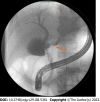Intraductal papillary neoplasm of the bile duct: The new frontier of biliary pathology
- PMID: 37900587
- PMCID: PMC10600795
- DOI: 10.3748/wjg.v29.i38.5361
Intraductal papillary neoplasm of the bile duct: The new frontier of biliary pathology
Abstract
Intraductal papillary neoplasms of the bile duct (IPNBs) represent a rare variant of biliary tumors characterized by a papillary growth within the bile duct lumen. Since their first description in 2001, several classifications have been proposed, mainly based on histopathological, radiological and clinical features, although no specific guidelines addressing their management have been developed. Bile duct neoplasms generally develop through a multistep process, involving different precursor pathways, ranging from the initial lesion, detectable only microscopically, i.e. biliary intraepithelial neoplasia, to the distinctive grades of IPNB until the final stage represented by invasive cholangiocarcinoma. Complex and advanced investigations, mainly relying on magnetic resonance imaging (MRI) and cholangioscopy, are required to reach a correct diagnosis and to define an adequate bile duct mapping, which supports proper treatment. The recently introduced subclassifications of types 1 and 2 highlight the histopathological and clinical aspects of IPNB, as well as their natural evolution with a particular focus on prognosis and survival. Aggressive surgical resection, including hepatectomy, pancreaticoduodenectomy or both, represents the treatment of choice, yielding optimal results in terms of survival, although several endoscopic approaches have been described. IPNBs are newly recognized preinvasive neoplasms of the bile duct with high malignant potential. The novel subclassification of types 1 and 2 defines the histological and clinical aspects, prognosis and survival. Diagnosis is mainly based on MRI and cholangioscopy. Surgical resection represents the mainstay of treatment, although endoscopic resection is currently applied to nonsurgically fit patients. New frontiers in genetic research have identified the processes underlying the carcinogenesis of IPNB, to identify targeted therapies.
Keywords: Bile duct neoplasms; Cholangiocarcinoma; Classification; Intraductal neoplasm of the bile duct; Intraductal papilloma; Treatment.
©The Author(s) 2023. Published by Baishideng Publishing Group Inc. All rights reserved.
Conflict of interest statement
Conflict-of-interest statement: The authors declare having no conflicts of interest.
Figures





References
-
- Chen TC, Nakanuma Y, Zen Y, Chen MF, Jan YY, Yeh TS, Chiu CT, Kuo TT, Kamiya J, Oda K, Hamaguchi M, Ohno Y, Hsieh LL, Nimura Y. Intraductal papillary neoplasia of the liver associated with hepatolithiasis. Hepatology. 2001;34:651–658. - PubMed
-
- Gordon-Weeks AN, Jones K, Harriss E, Smith A, Silva M. Systematic Review and Meta-analysis of Current Experience in Treating IPNB: Clinical and Pathological Correlates. Ann Surg. 2016;263:656–663. - PubMed
-
- Mondal D, Silva MA, Soonawalla Z, Wang LM, Bungay HK. Intraductal papillary neoplasm of the bile duct (IPN-B): also a disease of western Caucasian patients. A literature review and case series. Clin Radiol. 2016;71:e79–e87. - PubMed
Publication types
MeSH terms
LinkOut - more resources
Full Text Sources
Medical

